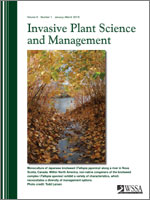In instances where vegetation plays a dominant role in the riparian landscape, the type and characteristics of species, particularly a dominant invasive, can alter water velocity at high flows when vegetation is inundated. However, quantifying this resistance in terms of riparian vegetation has largely been ignored or listed as a secondary characteristic on roughness reference tables. We calculated vegetation roughness based on measurements of plant stem stiffness, plant frontal area, stem density, and stem area of three dominant herbaceous plants along the Sprague River, Oregon: the invasive reed canarygrass, native creeping spikerush, and native inflated sedge. Results show slightly lower roughness values than those predicted for vegetation using reference tables. In addition, native creeping spikerush and invasive reed canarygrass exhibit higher roughness values than native inflated sedge, which exhibits values lower than the other two species. These findings are of particular importance where the invasive reed canarygrass is outcompeting native inflated sedge, because with invasive colonization, roughness is increasing in channel zones and therefore is likely changing channel processes. Direct depositional measurements show similar results.
Nomenclature: Reed canarygrass, Phalaris arundinacea L.; creeping spikerush, Eleocharis palustris (L.) Roemer & J.A. Schultes; inflated sedge, Carex vesicaria L.
Management Implications: This study examines the differences in roughness provided by the invasive reed canarygrass (Phalaris arundinacea) and comparable native species occupying stream channel locations along the Sprague River, Oregon. Results here show that the roughness provided by the invasive species is significantly different than the native inflated sedge (Carex vesicaria). In areas where the invasive is outcompeting the native inflated sedge, the increase in roughness provided by the invasive reed canarygrass will likely decrease water velocity when the invasive is inundated during floods. Decreases in water velocity will lead to increased deposition that may change channel form and processes. This is particularly important where channel shape and processes dictate water depth and therefore water temperature. The Sprague River and many other rivers throughout the Pacific Northwest that contain the invasive reed canarygrass could be experiencing changes in channel form. Such changes will alter habitat conditions for at-risk species such as salmon. Along the Sprague River, ongoing restoration and the potential for the reintroduction of salmon with the removal of two dams downstream of the watershed make the effects of this particular species notable. Along other rivers containing the invasive, special attention should be paid to differences in roughness when reed canarygrass is outcompeting native species and establishing monocultures that may eventually dominate the channel banks.





